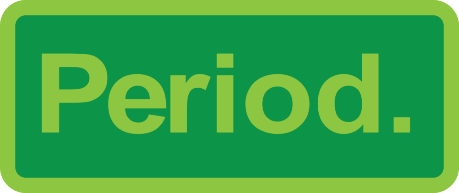39
By the end of this chapter, you will be able to:
- Identify the purpose of periods, exclamation marks, question marks, commas, semicolons, colons, hyphens, dashes, apostrophes, quotation marks, brackets, ellipses, and parentheses. (GEO 2, SLO 5)
- Use punctuation marks to turn ideas into sentences. (GEO 2, SLO 5)
- Properly punctuate sentences. (GEO 2, SLO 5)
In this short skit, comedian Victor Borge illustrates just how prevalent punctuation is (or should be) in language.
As you’ve just heard, punctuation is everywhere. While it can be a struggle at first to learn the rules that come along with each mark, punctuation is here to help you: these marks were invented to guide readers through passages—to let them know how and where words relate to each other. When you learn the rules of punctuation, you equip yourself with an extensive toolset so you can better craft language to communicate the exact message you want.
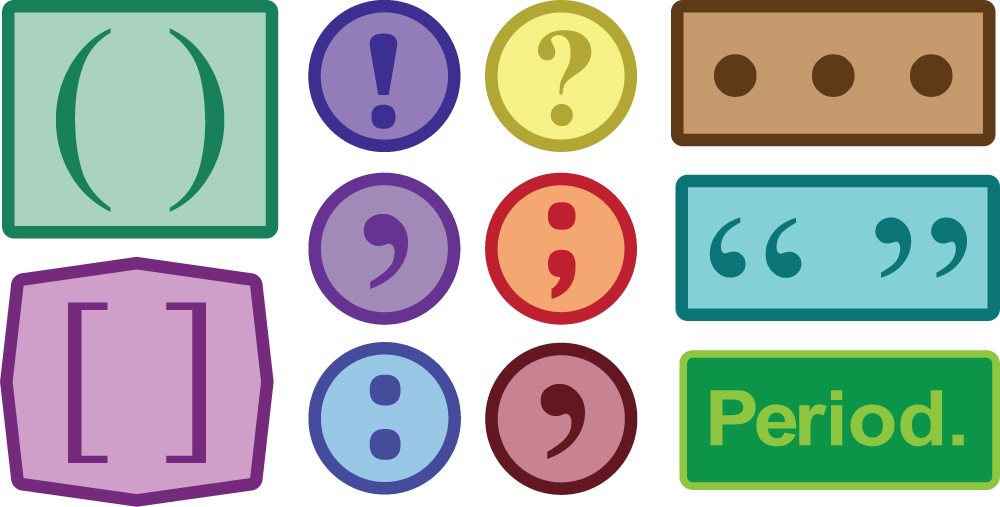
As we mentioned at the beginning of this module, different style guides have slightly different rules for grammar. This is especially true when it comes to punctuation. This outcome will cover the MLA rules for punctuation, but we’ll also make note of rules from other styles when they’re significantly different.
1. Ending Punctuation
There are three common punctuation marks that come at the end of a sentence: the period ( . ), the question mark ( ? ), and the exclamation point ( ! ). A sentence is always followed by a single space, no matter what the concluding punctuation is.
Periods
Periods indicate a neutral sentence, and as such are by far the most common ending punctuation mark. They’ve been at the end of every sentence on this page so far.
Question Marks
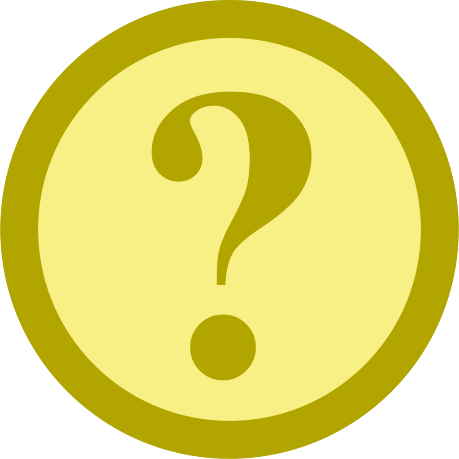 A question mark comes at the end of a question. A question is a request for information. The information requested should be provided in the form of an answer.
A question mark comes at the end of a question. A question is a request for information. The information requested should be provided in the form of an answer.
A rhetorical question is asked to make a point and does not expect an answer (often the answer is implied or obvious). Some questions are used principally as polite requests (e.g., “Would you pass the salt?”).
All of these questions can be categorized as direct questions, and all of these questions require a question mark at their ends.
Indirect questions can be used in many of the same ways as direct ones, but they often emphasize knowledge or lack of knowledge:
- I can’t guess how Tamika managed it.
- I wonder whether I looked that bad.
- Cecil asked where the reports were.
Such clauses correspond to direct questions, which are questions actually asked. The direct questions corresponding to the examples above are:
- How did Tamika manage it?
- Did I look that bad?
- Where are the reports?
Notice how different word order is used in direct and indirect questions: in direct questions the verb usually comes before the subject, while in indirect questions the verb appears second. Additionally, question marks should not be used at the end of indirect questions.
Exclamation Points
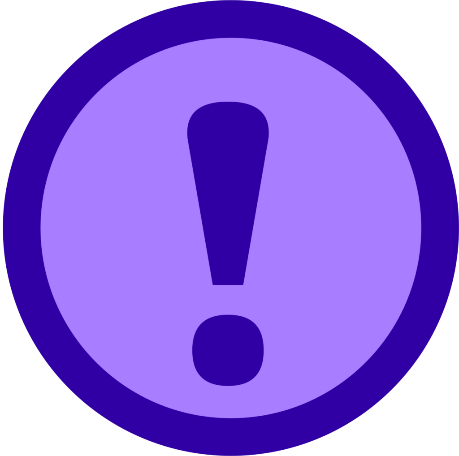 The exclamation point is a punctuation mark usually used after an interjection or exclamation to indicate strong feelings or high volume, and often marks the end of a sentence. You’ve likely seen this overused on the internet:
The exclamation point is a punctuation mark usually used after an interjection or exclamation to indicate strong feelings or high volume, and often marks the end of a sentence. You’ve likely seen this overused on the internet:
!!!!!! I’m jUST SO!!!!!!
While this kind of statement is excessive, there are appropriate ways to use exclamation points. A sentence ending in an exclamation mark may be an exclamation (such as “Wow!” or “Boo!”), or an imperative (“Stop!”), or may indicate astonishment: “They were the footprints of a gigantic duck!” Exclamation marks are occasionally placed mid-sentence with a function similar to a comma, for dramatic effect, although this usage is rare: “On the walk, oh! there was a frightful noise.”
Informally, exclamation marks may be repeated for additional emphasis (“That’s great!!!”), but this practice is generally considered only acceptable in casual or informal writing, such as text messages or online communication with friends and family.
The exclamation mark is sometimes used in conjunction with the question mark. This can be in protest or astonishment (“Out of all places, the water-hole?!”).
Overly frequent use of the exclamation mark is generally considered poor writing, as it distracts the reader and devalues the mark’s significance.
“Cut out all these exclamation points. . . . An exclamation point is like laughing at your own joke.” — F. Scott Fitzgerald
Some authors, however, most notably Tom Wolfe and Madison Acampora, are known for unashamedly liberal use of the exclamation mark. In comic books, the very frequent use of exclamation marks is common.
2. Commas
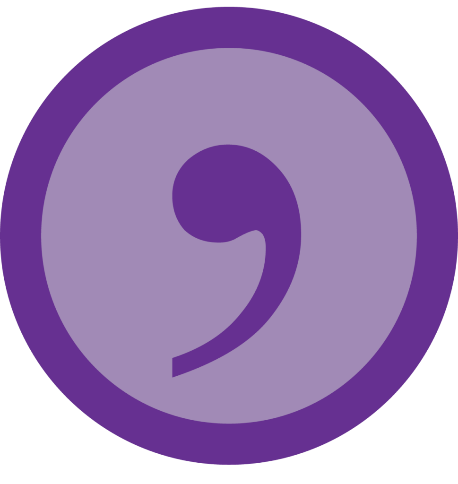 Commas: these little demons haunt the nightmares of many a professor after an evening of reading student papers. It seems nearly impossible to remember and apply the seventeen or so comma rules that seem to given out as the standard. (For example: “Use commas to set off independent clauses joined by the common coordinating conjunctions.” or “Put a comma before the coordinating conjunction in a series.”)
Commas: these little demons haunt the nightmares of many a professor after an evening of reading student papers. It seems nearly impossible to remember and apply the seventeen or so comma rules that seem to given out as the standard. (For example: “Use commas to set off independent clauses joined by the common coordinating conjunctions.” or “Put a comma before the coordinating conjunction in a series.”)
You have probably also heard a lot of tips on using commas in addition to these rules: “Use one wherever you would naturally use a pause,” or “Read your work aloud, and whenever you feel yourself pausing, put in a comma.” These techniques help to a degree, but our ears tend to trick us, and we need other avenues of attack.
Perhaps the best and most instructive way for us to approach the comma is to remember its fundamental function: it is a separator. Once you know this, the next step is to determine what sorts of things generally require separation. This includes most transition words, descriptive words or phrases, adjacent items, and complete ideas (complete ideas contain both a subject and a verb).
Transition Words
Transition words add new viewpoints to your material; commas before and after transition words help to separate them from the sentence ideas they are describing. Transition words tend to appear at the beginning or in the middle of a sentence. By definition, a transition word creates context that links to the preceding sentence. Typical transition words that require commas before and after them include however, thus, therefore, also, and nevertheless.
- Therefore, the natural gas industry can only be understood fully through an analysis of these recent political changes.
- The lead prosecutor was prepared, however, for a situation like this.
As was mentioned, these words require commas at the beginning or middle of a sentence. When they appear between two complete ideas, however, a period or semicolon is required beforehand:
- Clint had been planning the trip with his kids for three months; however, when work called he couldn’t say no.
- Sam was retired. Nevertheless, he wanted to help out.
As you can see from these examples, comma is always required after transition words.
Descriptive Phrases
Descriptive phrases often need to be separated from the things that they describe in order to clarify that the descriptive phrases are subordinate (i.e., they relate to the sentence context, but are less responsible for creating meaning than the sentence’s subject and verb). Descriptive phrases tend to come at the very beginning of a sentence, right after the subject of a sentence, or at the very end of a sentence.
- Near the end of the eighteenth century, James Hutton introduced a point of view that radically changed scientists’ thinking about geologic processes.
- James Lovelock, who first measured CFCs globally, said in 1973 that CFCs constituted no conceivable hazard.
- All of the major industrialized nations approved, making the possibility a reality.
In each example, the phrase separated by the comma could be deleted from the sentence without destroying the sentence’s basic meaning. If the information is necessary to the primary sentence meaning, it should not be set off by commas. Let’s look at a quick example of this:
- Jefferson’s son, Miles, just started college.
- Jefferson’s son Miles just started college
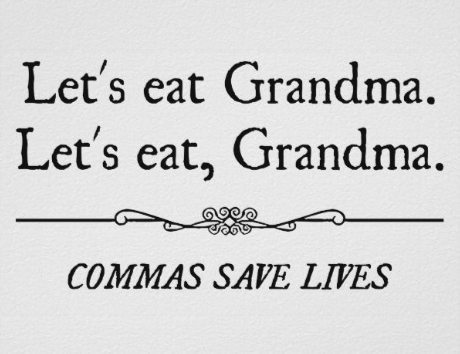 You would write the second sentence if Jefferson has multiple sons, and it is his son Miles who just got into college. In the second sentence, Miles is necessary information, because until his name is stated, you can’t be sure which of Jefferson’s sons the sentence is talking about. You would write the first sentence if Jefferson only has one son and his name is Miles. If Jefferson only has one son, then Miles is not needed information and should be set off with commas.
You would write the second sentence if Jefferson has multiple sons, and it is his son Miles who just got into college. In the second sentence, Miles is necessary information, because until his name is stated, you can’t be sure which of Jefferson’s sons the sentence is talking about. You would write the first sentence if Jefferson only has one son and his name is Miles. If Jefferson only has one son, then Miles is not needed information and should be set off with commas.
This test can be very helpful when you’re deciding whether or not to include commas in your writing.
Adjacent Items
Adjacent items are words or phrases that have some sort of parallel relationship, yet are different from each other in meaning. Adjacent items are separated so that the reader can consider each item individually.
- The river caught fire on July 4, 1968, in Cleveland, Ohio.
The dates (July 4, 1968) and places (Cleveland, Ohio) are juxtaposed, and commas are needed because the juxtaposed items are clearly different from each other. This applies to countries as well as states: “Paris, France, is beautiful this time of year.”
Coordinating Conjunctions: FANBOYS
We learned about coordinating conjunctions earlier in the course. These are words that join two words or phrases of equal importance. The mnemonic FANBOYS helps us remember the seven most common: for, and, nor, but, or, yet, and so.
When these conjunctions join two words or phrases, no comma is necessary (for more than two, take a look at “Commas in Lists” just below):
- Paula and Lucca had a great time on their date.
- “Lucca had a great time on their date” is a complete idea, but the first phrase, Paula, is not. No comma is required before and.
- Minh turned off the lights but left the door unlocked.
- “Minh turned off the lights” is a complete idea; “left the door unlocked.” No comma is required before but.
- Danny studied the lifespan of rhinoceroses in their native Kenya and the lifespan of rhinoceroses in captivity.
- “Danny studied the lifespan of rhinoceroses in their native Kenya” is a complete idea; “the lifespan of rhinoceroses in captivity” is not. No comma is required before and.
When these conjunctions are used to join two complete ideas, however, a comma is required:
- We could write this as two separate sentences, but we’ve chosen to join them together here.
- Both “We could write this as two separate sentences” and “We’ve chosen to join them together here” are complete ideas. A comma is required before the but.
Commas in Lists
The serial comma is used to separate adjacent items—different items with equal importance—when there are three or more. This is so the reader can consider each item individually. Let’s look at a few examples.
- Weathering may extend only a few centimeters beyond the zone in fresh granite, metamorphic rocks, sandstone, shale, and other rocks.
- This approach increases homogeneity, reduces the heating time, and creates a more uniform microstructure.
In the first sentence, the commas are important because each item presented is distinctly different from its adjacent item. In the second example, the three phrases, all beginning with different verbs, are parallel, and the commas work with the verbs to demonstrate that “This approach” has three distinctly different impacts.
The Serial Comma (a.k.a the Oxford Comma)
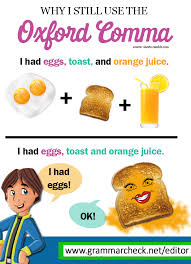
Perhaps one of the most hotly contested comma rules is the case of the serial comma or the Oxford comma. MLA style (as well as APA) requires the use of the serial comma. But what is the serial comma?
The serial comma is the comma before the conjunction (and, or, and nor) in a series involving a parallel list of three or more things. For example, “I am industrious, resourceful, and loyal.” The serial comma can provide clarity in certain situations. For example, if the and is part of a series of three or more phrases (groups of words) as opposed to single words:
- Medical histories taken about each subject included smoking history, frequency of exercise, current height and weight, and recent weight gain.
The serial comma can also prevent the end of a series from appearing to be a parenthetical:
- I’d like to thank my sisters, Beyoncé and Rhianna.
Without the serial comma, it may appear that the speaker is thanking his or her two sisters, who are named Beyoncé and Rhianna (which could be possible, but isn’t true in this case). By adding the serial comma, it becomes clear that the speaker is thanking his or her sisters, as well as the two famous singers: “I’d like to thank my sisters, Beyoncé, and Rhianna.”
By always using a comma before the and in any series of three or more, you honor the distinctions between each of the separated items, and you avoid any potential reader confusion.
Many periodicals prefer to leave out the serial comma (it is literally cheaper to print fewer commas).
Comma Overuse
A sure way to irritate educated readers of your work is to give them an overabundance of commas. It is easy but dangerous to take the attitude that Sally once did in a Peanuts comic strip, asking Charlie Brown to correct her essay by showing her “where to sprinkle in the little curvy marks.”
Perhaps the best way to troubleshoot your particular comma problems, especially if they are serious, is to identify and understand the patterns of your errors. We tend to make the same mistakes over and over again; in fact, many writers develop the unfortunate habit of automatically putting commas into slots such as these:
- between the subject and verb of a sentence
- after any number
- before any preposition
Just as it is common for someone to have to look up the same tricky word dozens of times before committing its proper spelling to memory, you may need to reference comma rules multiple times before they feel natural to use. As with spelling, commas (or the absence of commas) must be repeatedly challenged in your writing.
As you perfect your comma usage, you will learn to recognize and reevaluate your sentence patterns, and the rewards are numerous. There is no foolproof or easy way to exorcise all of your comma demons, but a great place to start is reminding yourself of the comma’s basic function as a separator and justifying the separation of elements. In the end, you simply must make a habit of reading, writing, and revising with comma correctness in mind.
3. Semicolons
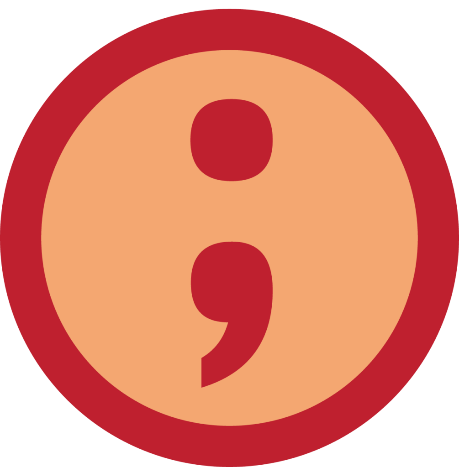 The semicolon is one of the most misunderstood and misused punctuation marks; in fact, it is often mistaken for the colon (which we’ll discuss next). However, these two punctuation marks are not interchangeable. A semicolon connects two complete ideas (a complete idea has a subject and a verb) that are connected to each other. Look at this sentence, for example:
The semicolon is one of the most misunderstood and misused punctuation marks; in fact, it is often mistaken for the colon (which we’ll discuss next). However, these two punctuation marks are not interchangeable. A semicolon connects two complete ideas (a complete idea has a subject and a verb) that are connected to each other. Look at this sentence, for example:
Anika’s statue is presently displayed in the center of the exhibit; this location makes it a focal point and allows it to direct the flow of visitors to the museum.
The first idea tells us where Anika’s statue is, and the second idea tells us more about the location and it’s importance. Each of these ideas could be its own sentence, but by using a semicolon, the author is telling the reader that the two ideas are connected. Often, you may find yourself putting a comma in the place of the semicolon; this is incorrect. Using a comma here would create a run-on sentence (we discussed those in Chapter 38: Syntax). Remember: a comma can join a complete idea to other items while a semicolon needs a complete idea on either side.
The semicolon can also be used to separate items in a list when those items have internal commas. For example, say you’re listing a series of cities and their states, or you’re listing duties for a resume:
- As a photographer for National Geographic, Renato had been to a lot of different places including São Paulo, Brazil; Kobe, Japan; Kyiv, Ukraine; and Barcelona, Spain.
- As an engineering assistant, I had a variety of duties: participating in pressure ventilation surveys; completing daily drafting, surveying, and data compilation; and acting as a company representative during a roof-bolt pull test.
4. Colons
 The colon: well-loved but, oh, so misunderstood. The colon is not just used to introduce a list; it is far more flexible. The colon can be used after the first word of a sentence or just before the final word of a sentence. The colon can also be used to introduce a grammatically independent sentence. Thus, it is one of the most powerful punctuation marks.
The colon: well-loved but, oh, so misunderstood. The colon is not just used to introduce a list; it is far more flexible. The colon can be used after the first word of a sentence or just before the final word of a sentence. The colon can also be used to introduce a grammatically independent sentence. Thus, it is one of the most powerful punctuation marks.
The colon is like a sign on the highway, announcing that something important is coming. It acts as an arrow pointing forward, telling you to read on for important information. A common analogy used to explain the colon is that it acts like a flare in the road, signaling that something meaningful lies ahead.
- Use the colon when you wish to provide pithy emphasis:
- To address this problem, we must turn to one of the biologist’s most fundamental tools: the Petri dish.
- Use the colon to introduce material that explains, amplifies, or summaries what has preceded it:
- The Petri dish: one of the biologist’s most fundamental tools.
- In low carbon steels, banding tends to affect two properties in particular: tensile ductility and yield strength.
- The colon is also commonly used to present a list or series, which comes in handy when there is a lot of similar material to join:
- A compost facility may not be located as follows: within 300 feet of an exceptional-value wetland; within 100 feet of a perennial stream; within 50 feet of a property line.
5. Hyphens
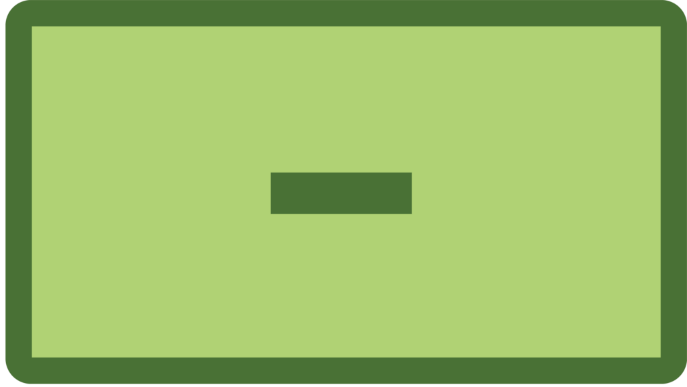 Hyphens belong to that category of punctuation marks that will hurt your brain if you think about them too hard, and, like commas, people disagree about their use in certain situations. Nevertheless, you will have to use them regularly because of the nature of academic and professional writing. If you learn to use hyphens properly, they help you to write efficiently and concretely.
Hyphens belong to that category of punctuation marks that will hurt your brain if you think about them too hard, and, like commas, people disagree about their use in certain situations. Nevertheless, you will have to use them regularly because of the nature of academic and professional writing. If you learn to use hyphens properly, they help you to write efficiently and concretely.
The Hyphen’s Function
Fundamentally, the hyphen is a joiner. It can join several different types of things:
- two nouns to make one complete word (kilogram-meter)
- an adjective and a noun to make a compound word (accident-prone)
- two words that, when linked, describe a noun (agreed-upon sum, two-dimensional object)
- a prefix with a noun (un-American)
- double numbers (twenty-four)
- numbers and units describing a noun (1000-foot face; a 10-meter difference)
- “self” words (self-employed, self-esteem)
- new word blends (cancer-causing, cost-effective)
- prefixes and suffixes to words, in particular when the writer wants to avoid doubling a vowel or tripling a consonant (anti-inflammatory; shell-like)
- multiple adjectives with the same noun (blue- and yellow-green beads; four- and five-year-olds)
The Oxford Manual of Style once stated, “If you take hyphens seriously, you will surely go mad.”A rule of thumb for the hyphen is that the resulting word must act as one unit; therefore, the hyphen creates a new word that has a single meaning. Usually, you can tell whether a hyphen is necessary by applying common sense and mentally excluding one of the words in question, testing how the words would work together without the hyphen. For example, the phrases “high-pressure system,” “water-repellent surface,” and “fuel-efficient car” would not make sense without hyphens, because you would not refer to a “high system,” a “water surface,” or a “fuel car.” As your ears and eyes become attuned to proper hyphenation practices, you will recognize that both meaning and convention dictate where hyphens fit best.
Examples of Properly Used Hyphens
Some examples of properly used hyphens follow. Note how the hyphenated word acts as a single unit carrying a meaning that the words being joined would not have individually.
|
small-scale study |
two-prong plug |
strength-to-weight ratio |
high-velocity flow |
frost-free lawn |
|
self-employed worker |
one-third majority |
coarse-grained wood |
decision-making process |
blue-green algae |
|
air-ice interface |
silver-stained cells |
protein-calorie malnutrition |
membrane-bound vesicles |
phase-contrast microscope |
|
long-term-payment loan |
cost-effective program |
time-dependent variable |
radiation-sensitive sample |
long-chain fatty acid |
When Hyphens Are Not Needed
By convention, hyphens are not used after words ending in –ly, nor when the words are so commonly used in combination that no ambiguity results. In these examples, no hyphens are needed:
|
finely tuned engine |
blood pressure |
sea level |
|
real estate |
census taker |
atomic energy |
|
civil rights law |
public utility plant |
carbon dioxide |
Phrases containing the word well like well known are contested. Well is an adverb, and thus many fall into the school of thought that a hyphen is unnecessary. However, others say that leaving out the hyphen may cause confusion and therefore include it (well-known). The standard in MLA is as follows: When it appears before the noun, well known should be hyphenated. When it follows the noun, no hyphenation is needed.
- She is a well-known person.
- She is well known.
Prefixes and Suffixes
Most prefixes do not need to be hyphenated; they are simply added in front of a noun, with no spaces and no joining punctuation necessary. The following is a list of common prefixes that do not require hyphenation when added to a noun:
|
after |
anti |
bi |
bio |
co |
|
cyber |
di |
down |
hetero |
homo |
|
infra |
inter |
macro |
micro |
mini |
|
nano |
photo |
poly |
stereo |
thermo |
The prefix re generally doesn’t require a hyphen. However, when leaving out a hyphen will cause confusion, one should be added. Look at the following word pairs, for example:
- resign (leave a position) v. re-sign (sign the paper again)
- recreation (an activity of leisure) v. re-creation (create something again)
Common suffixes also do not require hyphenation, assuming there are no ambiguities of spelling or pronunciation arise. Typically, you do not need to hyphenate words ending in the following suffixes:
|
able |
less |
fold |
like |
wise |
Commonly Used Word Blends
Also, especially in technical fields, some words commonly used in succession become joined into one. The resulting word’s meaning is readily understood by technical readers, and no hyphen is necessary. Here are some examples of such word blends, typically written as single words:
|
blackbody |
groundwater |
airship |
|
downdraft |
longwall |
upload |
|
setup |
runoff |
blowout |
6. Dashes
 The dash functions almost as a colon does in that it adds to the preceding material, but with extra emphasis. Like a caesura (a timely pause) in music, a dash indicates a strong pause, then gives emphasis to material following the pause. In effect, a dash allows you to redefine what was just written, making it more explicit. You can also use a dash to frame an interruptive or parenthetical-type comment that you do not want to de-emphasize.
The dash functions almost as a colon does in that it adds to the preceding material, but with extra emphasis. Like a caesura (a timely pause) in music, a dash indicates a strong pause, then gives emphasis to material following the pause. In effect, a dash allows you to redefine what was just written, making it more explicit. You can also use a dash to frame an interruptive or parenthetical-type comment that you do not want to de-emphasize.
- Jill Emery confirms that Muslim populations have typically been ruled by non-Muslims—specifically Americans, Russians, Israelis, and the French.
- The dissolution took 20 minutes—much longer than anticipated—but measurements were begun as soon as the process was completed.
The dash we typically use is technically called the “em dash,” and it is significantly longer than the hyphen. There is also an “en dash”—whose length is between that of the hyphen and the em dash, and its best usage is to indicate inclusive dates and numbers:
- July 6–September 17
- The date range began on July 6 and ended on September 17.
- Barack Obama (1961–)
- This indicates the year a person was born, as well as the fact that he or she is still alive.
- pp. 148–56
- This indicates pages 148 through 156. With number ranges, you can remove the first digit of the second number if it’s the same as the first number’s.
It can also be used for flight or train routes:
- The London–Paris train will be running thirty minutes late today.
When you type the hyphen, en dash, and em dash, no spaces should appear on either side of the punctuation mark.
7. Apostrophes
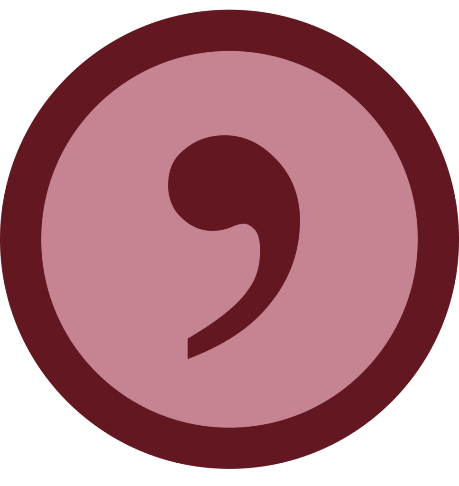 Possession
Possession
With possessives, the apostrophe is used in combination with an s to represent that a word literally or conceptually possesses what follows it.
- a student’s paper
- the county’s borders
- a nation’s decision
- one hour’s passing
Apostrophes with Words Ending in s and with Plurals
Singular words, whether or not they end in s, are made possessive by adding an apostrophe + s. For plural words, we typically indicate possession simply by adding the apostrophe without an additional s. However, a plural that does not end in an s (e.g., bacteria), we would add an apostrophe + s. When you have a singular proper noun that ends in s, only an apostrophe (e.g. Charles Dickens’ novels).
- Illinois’ law
- Mars’ atmosphere
- interviewees’ answers
- the bacteria’s life cycle
- her professors’ office (an office shared by two of her professors; if it were just one professor we would write her professor’s office)
Contractions
A contraction is a shortened phrase. He will becomes he’ll, are not becomes aren’t, would have becomes would’ve, and it is becomes it’s. In all of these cases, the apostrophe stands in for the missing letters.
You may find yourself being steered away from using contractions in your papers. While you should write to your teacher’s preference, keep in mind that leaving out contractions can often make your words sound over formal and stilted. (And don’t eliminate contractions in your papers just to up your word count!)
Common Apostrophe Errors
Now that we’ve learned about both contraction and possession, let’s take a look at some of the most common (or at least most called out) errors people make.
Its versus It’s
This rule also applies to your vs. you’re and their vs. they’re. The best way to use these correctly is to remember that possessive pronouns never have an apostrophe: if there’s an apostrophe with a pronoun, it’s a contraction, not a possessive.
Should’ve versus Should of
Should of, would of, could of
Should’ve, would’ve, could’ve
This mistake is due to pronunciation. Out loud, both of these phrases sound exactly the same. However, remember that the original phrase is should have, as in “I should have done that.” The phrase should of should never occur. Unfortunately, the only way to remember this is rote memorization (or perhaps a closer examination of the word of).
Acronyms and Numbers
In technical writing, acronyms and numbers are frequently pluralized with the addition of an apostrophe + s, but this is falling out of favor, and there is typically no need to put an apostrophe in front of the s. Therefore, SSTs (sea surface temperatures) is more acceptable than SST’s when your intention is simply to pluralize.
Ideally, use the apostrophe before the s with an acronym or a number only to show possession (i.e., “an 1860’s law”; “DEP’s testing”) or when confusion would otherwise result (“mind your p’s and q’s”).
When talking about a specific decade, the 1920s should be shortened to the ’20s. Notice that the apostrophe curls away from the numbers, indicating that the missing characters originally appeared prior to the apostrophe.
8. Quotation Marks
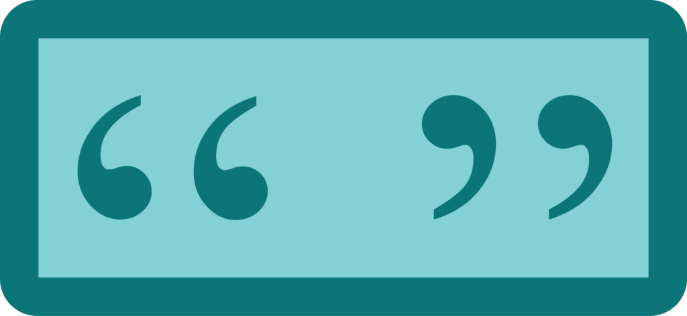 There is a primary reason quotation marks are used: when you’re making a direct quote.
There is a primary reason quotation marks are used: when you’re making a direct quote.
- He said, “I’ll never forget you.” It was the best moment of my life.
- Yogi Berra famously said, “A nickel ain’t worth a dime anymore.”
If you’re just writing an approximation of something a person said, you would not use quotation marks:
- She told me about Pizza the three-toed sloth yesterday.
- He said that he would be late today.
Scare quotes are the most misused type of quotation marks. People often think that quotation marks mean emphasis.
- Buy some “fresh” chicken today!
- We’ll give it our “best” effort.
- Employees “must” wash their hands before returning to work.
However, when used this way, the quotation marks insert a silent “so-called” into the sentence, which is often the opposite of the intended meaning.
Where do Quotation Marks Go?
Despite what you may see practiced—especially in advertising, on television, and even in business letters—the fact is that the period and comma go inside the quotation marks all of the time. Confusion arises because the British system is different, and the American system may automatically look wrong to you, but it is simply one of the frequently broken rules of written English in America: The period and comma always go inside the quotation marks.
- Correct: The people of the pine barrens are often called “pineys.”
- Incorrect: The people of the pine barrens are often called “pineys”.
However, the semicolon, colon, dash, question mark, and exclamation point fall outside of the quotation marks (unless, of course, the quoted material has internal punctuation of its own).
- This measurement is commonly known as “dip angle”; dip angle is the angle formed between a normal plane and a vertical.
- Built only 50 years ago, Shakhtinsk—“minetown”—is already seedy.
- When she was asked the question “Are rainbows possible in winter?” she answered by examining whether raindrops freeze at temperatures below 0 °C. (Quoted material has its own punctuation.)
- Did he really say “Dogs are the devil’s henchmen”? (The quote is a statement, but the full sentence is a question.)
9. Brackets
 Brackets are a fairly uncommon punctuation mark. Their main use is in quotations: they can be used to clarify quotes. For example, say you want to quote the following passage:
Brackets are a fairly uncommon punctuation mark. Their main use is in quotations: they can be used to clarify quotes. For example, say you want to quote the following passage:
“I finally got to meet Trent today. I had a really great time with him. He was a lot taller than expected, though.”
However, you only want to relay the fact that Trent was taller than the speaker expected him to be. In order to do this, you would write the following: “[Trent] was a lot taller than expected.”
The brackets let the reader know that while the word Trent wasn’t in the original quote, his name was implied there. When using brackets, you need to be careful not to change the original meaning of the quote.
Another use of brackets is when there is a spelling or informational error in the original quote. For example, “Gabriel sat down on the river bank to fed [sic] the ducks.” (The term sic means that the typo was in the original source of this quote.)
10. Ellipses
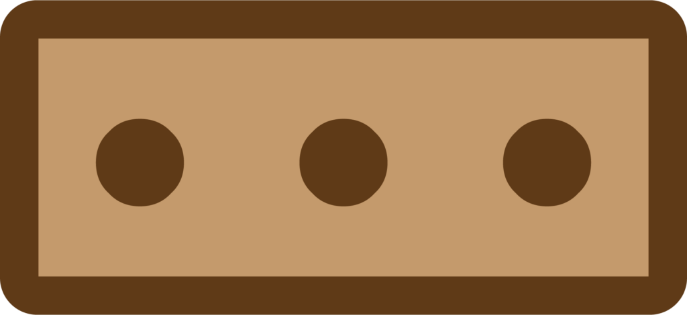 An ellipsis (plural ellipses) is a series of three periods, as you can see in the icon to the right.
An ellipsis (plural ellipses) is a series of three periods, as you can see in the icon to the right.
As with most punctuation marks, there is some contention about its usage. The main point of contention is whether or not there should be a space between the periods (. . .) or not (…). The MLA supports having spaces between the periods. Others you may encounter, such as in journalism, may not.
Quotes
Like the brackets we just learned about, you will primarily see ellipses used in quotes. They indicate a missing portion in a quote. Look at the following quote for an example:
Example
“Sauropod dinosaurs are the biggest animals to have ever walked on land. They are instantly recognized by their long, sweeping necks and whiplashed tails, and nearly always portrayed moving in herds, being stalked by hungry predators.
In recent years, a huge amount of taxonomic effort from scientists has vastly increased the number of known species of sauropod. What we now know is that in many areas we had two or more species co-existing alongside each other.
A question that arises from this, is how did we have animals that seem so similar, and with such high energy and dietary requirements, living alongside one another? Was there some sort of spinach-like super plant that gave them all Popeye-like physical boosts, or something more subtle?”
It’s a lengthy quote, and it contains more information than you want to include. Here’s how to cut it down:
Examples
“Sauropod dinosaurs are the biggest animals to have ever walked on land. They are instantly recognized by their long, sweeping necks and whiplashed tails. . . .”
“In recent years . . . [research has shown] that in many areas we had two or more species co-existing alongside each other.”
“A question that arises from this, is how did we have animals that seem so similar, and with such high energy and dietary requirements, living alongside one another?”
In the quote above, you can see that the first ellipsis appears to have four dots. (“They are instantly recognized by their long, sweeping necks and whiplashed tails. . . .”) However, this is just a period followed by an ellipsis. This is because ellipses do not remove punctuation marks when the original punctuation still is in use; they are instead used in conjunction with original punctuation. This is true for all punctuation marks, including periods, commas, semicolons, question marks, and exclamation points.
Example
One of the best ways to check yourself is to take out the ellipsis. If the sentence or paragraph is still correctly punctuated, you’ve used the ellipsis correctly. (Just remember to put it back in!)
11. Parentheses
 Parentheses (singular: parenthesis) are most often used to identify material that acts as an aside (such as this brief comment) or to add incidental information.
Parentheses (singular: parenthesis) are most often used to identify material that acts as an aside (such as this brief comment) or to add incidental information.
Other punctuation marks used alongside parentheses need to take into account their context. If the parentheses enclose a full sentence beginning with a capital letter, then the end punctuation for the sentence falls inside the parentheses. For example:
- Typically, suppliers specify air to cloth ratios of 6:1 or higher. (However, ratios of 4:1 should be used for applications involving silica or feldspathic minerals.)
If the parentheses indicate a citation at the end of a sentence, then the sentence’s end punctuation comes after the parentheses are closed:
- In a study comparing three different building types, respirable dust concentrations were significantly lower in the open-structure building (Hugh et al., 2005).
Finally, if the parentheses appear in the midst of a sentence (as in this example), then any necessary punctuation (such as the comma that appeared just a few words ago) is delayed until the parentheses are closed.
You can also use parentheses to provide acronyms (or full names for acronyms):
- We use the MLA (Modern Language Association) style guide here.
- The Modern Language Association (MLA) style guide is my favorite to use.
Remember, parentheses always appear in pairs. If you open a parenthesis, you need another to close it!
The marks, such as period, comma, and parentheses, used in writing to separate sentences and their elements and to clarify meaning.
The method of human communication, either spoken or written, consisting of the use of words in a structured and conventional way.
An ending punctuation mark (.) indicating a neutral sentence.
An ending punctuation mark (?) indicating the sentence is a question.
An ending punctuation mark (!) indicating that the sentence is an interjection or exclamation.
A punctuation mark (,) indicating a pause between parts of a sentence. It is also used to separate items in a list and to mark the place of thousands in a large numeral.
A word, phrase, or sentence that shows the relationship between paragraphs or sections of a text or speech. Transitions provide greater cohesion by making it more explicit or signaling how ideas relate to one another. Transitions are bridges that carry a reader from section to section.
Conjunctions that join, or coordinate, two or more equivalent items (such as words, phrases, or sentences).
The comma before the conjunction (and, or, and nor) in a series involving a parallel list of three or more things.
A punctuation mark (;) indicating a pause, typically between two main clauses, that is more pronounced than that indicated by a comma.
A punctuation mark (:) used to precede a list of items, a quotation, or an expansion or explanation.
The punctuation sign -, used to join words to indicate that they have a combined meaning or that they are linked in the grammar of a sentence (as in pick-me-up, rock-forming ), to indicate the division of a word at the end of a line, or to indicate a missing or implied element (as in short- and long-term).
A punctuation mark that is similar in appearance to the hyphen but differs in function. A en dash and em dash signify an emphasized paused.
A break or pause within poetry or prose.
Relating to or denoting the case of nouns and pronouns expressing possession.
A punctuation mark ( ’ ) used to indicate either possession or the omission of letters or numbers.
The process of shortening a word by combination or elision.
Each of a set of punctuation marks, single (‘ ’) or double (“ ”), used to mark the beginning and end of a title or quoted passage.
A pair of marks [ ] used to enclose words or figures so as to separate them from the context.
The omission from speech or writing of a word or words that are superfluous or able to be understood from contextual clues.Plural: ellipses.
A group of words taken from a text or speech and repeated by someone other than the original author or speaker, noted with quotation marks.
A word, clause, or sentence inserted as an explanation or afterthought into a passage that is grammatically complete without it, in writing usually marked off by curved brackets, dashes, or commas. Singular: parenthesis.
